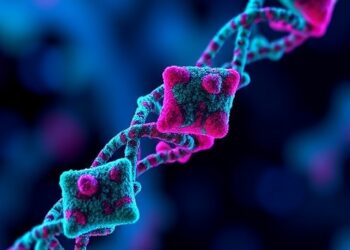Berlin, Germany: Differences in socioeconomic status (SES) are known to be linked to differences in the risk of developing disease. While people with lower SES are more likely to develop complex diseases such as diabetes and cardiovascular disease, those with a higher SES are at increased risk of developing certain types of cancer. Using biobank and national register data, researchers from Finland have now found that people with lower SES (educational achievement and occupation) have a greater genetic susceptibility to develop many other complex diseases such as rheumatoid arthritis, lung cancer, depression, and alcohol use disorder, as well as Type 2 diabetes, whereas those with a higher SES are more at risk of developing breast, prostate, and all cancers.
Berlin, Germany: Differences in socioeconomic status (SES) are known to be linked to differences in the risk of developing disease. While people with lower SES are more likely to develop complex diseases such as diabetes and cardiovascular disease, those with a higher SES are at increased risk of developing certain types of cancer. Using biobank and national register data, researchers from Finland have now found that people with lower SES (educational achievement and occupation) have a greater genetic susceptibility to develop many other complex diseases such as rheumatoid arthritis, lung cancer, depression, and alcohol use disorder, as well as Type 2 diabetes, whereas those with a higher SES are more at risk of developing breast, prostate, and all cancers.
Dr Fiona Hagenbeek, a postdoctoral researcher at the Institute for Molecular Medicine Finland (FIMM), University of Helsinki, Finland, who will present her group‘s work at the annual conference of the European Society of Human Genetics today (Sunday), says that these promising initial results mean that it is likely that polygenic risk scores, which measure an individual‘s risk of a particular disease based on genetic information, could be added to the screening protocols for multiple diseases and in several countries. “Understanding that the impact of polygenic scores on disease risk is context-dependent may lead to further stratified screening protocols,“ she says. “For example, in the future, screening protocols for breast cancer may be adapted so that females with a high genetic risk and who are highly educated receive earlier or more frequent screening than females with lower genetic risk or less education.”
The researchers used genomics, SES, and health data from approximately 280,000 Finnish individuals in the FinnGen study, a research project in genomics and personalised medicine that aims to understand the genetic basis of diseases. The participants were aged 35 – 80 at the time of entry into the study. The study aimed to systematically assess the evidence of gene-environment interaction (GxE) through the differing genetic susceptibility to disease in diverse socioeconomic groups. While previous studies have shown the presence of such a difference in risk, this is the first to systematically assess GxE for SES in 19 complex diseases that have a high burden in high-income countries.
“Most clinical risk prediction models include basic demographic information such as biological sex and age, recognising that disease incidence differs between males and females, and is age-dependent,“ says Dr Hagenbeek. “Acknowledging that such context also matters when incorporating genetic information into healthcare is an important first step. But now, we can show that the genetic prediction of disease risk also depends on an individual’s socioeconomic background. So while our genetic information does not change throughout our lifetime, the impact of genetics on disease risk changes as we age or change our circumstances.“
The researchers hope that the study will be followed up to see whether further differences can be identified when looking at more specific aspects of educational and professional achievement. While their current results for profession generally mirror those for education, they do not match completely, indicating that each can provide unique information on the interplay of socioeconomic status and genetics on disease risk. Expanding the list of socioeconomic indices to be studied may bring about new insights into how the overlapping aspects of a person’s socioeconomic environment may, together with genetic information, influence their disease risk.
They will also compare their results across biobank studies from Finland, UK, Norway, and Estonia through the INTERVENE* consortium, allowing them to determine whether there are country or biobank-specific issues involved. “Our study focused solely on individuals of European ancestry, and it will also be important in the future to see whether our observations concerning the interplay of socioeconomic status and genetics for disease risk are replicated in people of multiple ancestries in higher and lower-income countries,“ says Dr Hagenbeek. “As the overall aim of incorporating genetic information into healthcare is to facilitate personalised medicine, we should not treat genetic information as ‘one size fits all‘. Rather, we should investigate and then include the circumstances that modify genetic risk when carrying out disease prediction.“
Professor Alexandre Reymond, from the Center for Integrative Genomics, University of Lausanne, Lausanne, Switzerland, and chair of the conference, said: “To really move to personalised health it will be essential to gauge both genetic and environmental risks. We should commend our Finnish colleagues for their part in spearheading this effort.”
(ends)
* INTERVENE is the ‘International consortium of integrative genomics prediction’, (https://www.interveneproject.eu/), a Horizon 2020 funded collaboration between 17 organizations from nine European countries and the USA. The overarching aim of the consortium is to develop tools for disease prevention, diagnosis, and personalised treatment by integrating human genetics and artificial intelligence. To this end, the INTERVENE consortium links human genetic data to electronic health records and registry data for over 1.7 million individuals from eight European and US biobank studies (FinnGen, Estonian Biobank, HUNT, Network for Italian Genomes, Partners Biobank, HUS Helsinki Biobank, UK Biobank, and Genomics England).
Abstract no. CO9.3 Gene-environment interplay of socioeconomic indices and complex diseases




